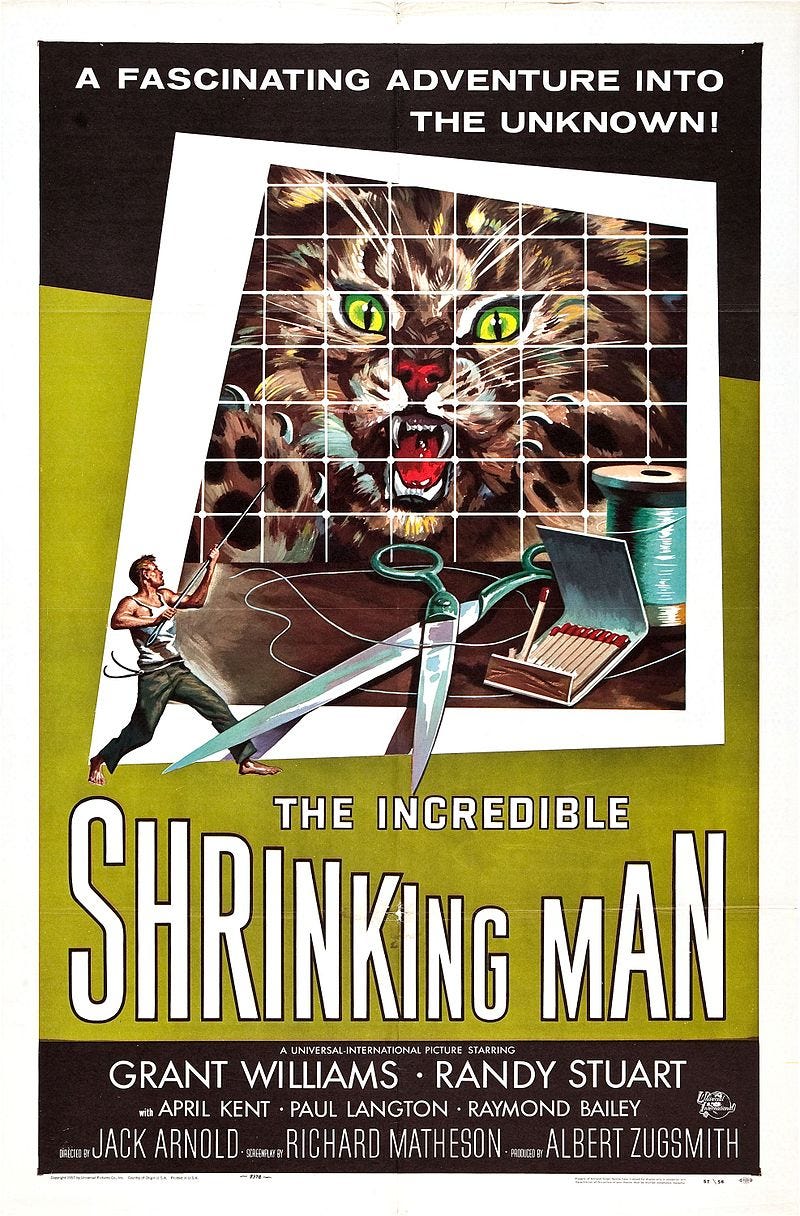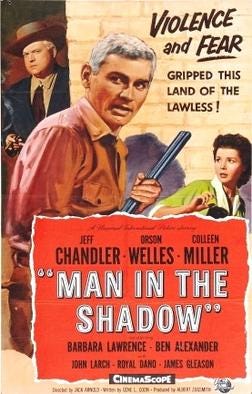The Crack of Dawn
Volume #457
9/13/23
Newsletter #457
The Crack of Dawn
Albert Zugsmith was a low-budget producer who started off making crappy little B-films and ended that way. When he started, he was making them for under $100,000, which is cheap even by B-movie standards of the early 1950s. He made films like, Captive Women (1952), Sword of Venus (1953), and a little piece of junk called Invasion USA (1952), about Communists invading America, which was padded out with a lot of military stock footage, still coming in at a lean 74 minutes. 1952 was the peak of the Hollywood red scare, with Congressional hearings held by the House Unamerican Activities Committee (HUAC). Invasion USA was exactly the right piece of crap movie at that exact right moment, grossing over a million dollars. Albert Zugsmith was hot shit for a half-second and got himself a producing contract at Universal.
After making a number of unexceptional B+ pictures, Zugsmith managed to make two terrific films, one of them kind of by mistake. He produced the classic horror/sci-fi film, The Incredible Shrinking Man (1957), for $750,000, which was a cheap film for Universal, and it was a hit. It scared the shit out of me as a kid.
The film was directed by Jack Arnold, who was on a run of making hit cheap sci-fi/horror films — It Came from Outer Space (1953), Creature from the Black Lagoon (1954), Tarantula (1955) – and The Incredible Shrinking Man is his masterpiece. However, both Albert Zugsmith and Jack Arnold aspired to better things, to make real, A-movies. They put together a B+ picture called Man in the Shadow (1957), that seemed to have all the right elements for a success, with Jeff Chandler and Orson Welles, a script by Gene L. Coon (writer/producer of the original Star Trek series, who has recently come up a couple of times – he invented Klingons and the Federation), and even an Oscar-winning cinematographer, Arthur Arling (who shot the gorgeous Technicolor in The Yearling [1946]), shooting this film in good-looking black & white CinemaScope. It’s a perfectly OK movie that was a surprise hit and made money.
It was time for both of them to make the big move into A-pictures. Albert Zugsmith put together the film Touch of Evil (1958), that would once again have Jack Arnold directing and Orson Welles co-starring. But this time Zugsmith was determined to get a real movie star. Please stick with me. Zugsmith hired a young TV writer named Paul Monash to adapt the novel, Badge of Evil, by Whit Masterson (who was actually two blacklisted writers). Flash forward and Paul Monash produced Butch Cassidy & the Sundance Kid (1969) and Brian De Palma’s Carrie (1976).
Anyway, Albert Zugsmith managed to get his script to Charlton Heston, who read it and liked it, but thought that playing the Latino lead, Vargas, might be problematic, but was willing to do it if Orson Welles was directing. He had misheard his agent when the script and the whole package was presented to him. He called his agent back and said he liked the script and couldn’t wait to be directed by Orson Welles. His agent corrected him and said, “Welles isn’t directing, he’s just acting. The film is being directed by Jack Arnold.” Heston said, “Who’s he?” The agent said, “He directed The Creature from the Black Lagoon.” Well, Charlton Heston was a giant movie star in 1958. He said very simply, “I’ll be in it if Orson Welles directs it, otherwise there’s no chance.”
It is its own famous Hollywood legend, but Orson Welles was always in the Hollywood doghouse. He was unjustly considered extravagant, and producers simply assumed that he always went over budget, which he didn’t. That’s another story.
Albert Zugsmith, being a Hollywood producer, did what he had to do. He shit-canned his pal Jack Arnold, who was an interesting guy with an interesting career. The first thing Orson Welles did was throw away Paul Monash’s script and start again. Orson Welles gets the writing credit.
Now, this is where this whole idea began. It’s taken me 630 words just to set it up.
The first day of shooting on Touch of Evil they were shooting the scene in Akim Tamaroff’s office, with him tying his tie in the mirror. Janet Leigh enters from behind him. As an historical note, Janet Leigh’s arm was broken, and in a cast, covered by a sweater.
I haven’t watched the movie in about a decade. I bought the DVD when Walter Murch fixed the sound to the way Welles wanted it — he left instructions — and I have not watched it again. Honestly, I O.D.-ed on it. And I obsessively watched this shot over and over again. It’s so complicated, yet so simple, that it takes my breath away. I would guess that most people wouldn’t notice it. I certainly didn’t notice the shot the first several times I saw the film.
Akim Tamiroff is tying his tie in a mirror and Janet Leigh enters from behind, with a sweater over her arm. They have a two pages of horseshit dialogue — “Yeah?” Yeah!” — delivered feistily, but shot so cleverly, as Tamiroff keeps goes back and forth between the mirror and Janet Leigh, so the shot keeps reforming — over his shoulder, close-up of her, reflection, no cuts — but all happening so naturally. It’s truly breathtaking. Then Charlton Heston as Vargas enters with all these cops. It’s still the same shot. Heston comes forward, walks a few steps up the hall, then goes into the bathroom. He knocks over a shoebox, for whatever reason, revealing it to be empty. He stands up, walks the few steps up the hall, and goes forward to where everyone else is. Cut. It’s a seven-minute hunk, which is a lot. They were scheduled to shoot five pages.
Welles spent all morning working the shot out and rehearsing it, then once he had it entirely together, it was lunchtime. So, they all went and ate, and they hadn’t run a foot of film through a camera. Poor Albert Zugsmith was used to the competent efficiency of Jack Arnold, and everyone else like him, which includes me. We would all have all dutifully gotten at least one shot. If you can’t get one shot by lunch, you’re probably fired on a TV show. Anyway, poor Albert Zugsmith was shitting bricks. It was true, all the rumors he’d heard about Welles and his extravagance.
Because Orson Welles was, in a few films, anyway, the best movie director there was, he came back and knocked the shot off like nothing. I’m sure he got several takes. It’s seven minutes long. It’s not gigantic, but it’s two pages more than were scheduled. And, oh, yeah, it’s one of the really amazing shots in the history of motion pictures. And they wrapped early. Albert Zugsmith was relieved, thanks goodness.
It is a really great, though not particularly meaningful, shot. But it made his point very clearly – I know what I’m doing. And I’m not Jack Arnold, or anybody else you’ve ever worked with.
Welles brought the whole film in on time, and it made money. And it won awards in Europe. Yet he could not get financing for his films. When all is said and done, Orson Welles whole career boils down to three movies: Citizen Kane (1941), The Magnificent Ambersons (1942) and Touch of Evil (1958). The poor son of a bitch, he only got to make three great films. My heart’s breaking.
Peter Bogdanovich’s book, This is Orson Welles, is terrific.
Albert Zugsmith, on the other hand, followed Touch of Evil by spending the entire decade of the 1960s producing basically smut. High School Confidential! (1958), The Beat Generation (1959), College Confidential (1960), Sex Kittens Go to College (1960), The Incredible Sex Revolution (1966); Psychedelic Sexualis (1966), Movie Star, American Style or; LSD, I Hate You. Etc.
Touch of Evil exists because of Charlton Heston not listening.




Jack Arnold directed my favorite Audie Murphy western, "No Name on the Bullet."
I never knew that Jack Arnold was attached to direct Touch of Evil! He made several very good Westerns. I really like "Red Sundown" (1956) with Rory Calhoun and Grant Williams (a talent who died too young). I have seen Touch of Evil in at least 20 years, but I will revisit it soon.